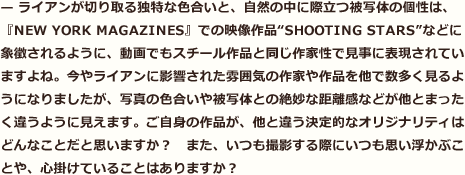

「GRIDS」の色合いは、ライブステージ上のカラフルな照明からきています。最終的なイメージを決めたあと、僕の独自のカラーパレットになるよう、写真に特別な手法を施しました。望遠レンズを使ってファンを撮ったり、彼らの顔のクロースアップを撮ったりもしました。ファンのユニークな感動や経験だけにフォーカスしたかったんです。それらをグリッド上に構成することで、僕独自のオーディエンスを作ることができました。

日本のファンがロックを聴きながら発狂している姿は是非撮りたいですね。日本人は、世界の中でも最も献身的なファンだと思うので。

The coloration of the grids comes from the colorful lighting that happens on stage. Then when I decide on a final image I apply many special techniques to the picture to make it my own color palatte. I use a telephoto lens to shoot the fans and get close ups on their faces. I want to only focus in on their unique emotion or experience at the concert. Then by assembling them in grids I can make up my own audience.

I'd love to shoot japanese fans loosing their minds while listening to rock and roll. I think people in Japan are some of the most dedicated and loyal fans.

2つのシリーズともに、自発性やカオス、そして色についてのシリーズです。「ANIMALS」は、野生の動物がどれだけ予想できないのかということについて、「GIRDS」は大勢のなかから予測できない何かを僕に見せてくれている人を探すことが主題です。
人の体を、動物たちが這うジャングルジムやプロップとして使うことが気に入ったんです。ヒトよりも、動物のパーソナリティのポートレイトにしようと心掛けました。ヌードの体は、動物たちとお互いに影響し合うように写真に取り入れました。このシリーズの中に、人のアイデンティティは見せなかったのですが、それは見る人が写真に自分たちを当てはめやすいようにしたかったからです。

長年にわたり、Twin Palmsが出版した本は好きでした。アレン・ギンズバーグの作品集や、ブルース・デヴィッドソンの『Brooklyn Gang』などもここから刊行されていたしね。2005年から僕のところに出版の声をかけてもらったんだ。皆から「アマゾンでバックオーダーしても、全然来ない!」って怒鳴られていました。オーバータイムで作業していたのですが、大きいモノグラフにできるような良い作品が十分あると思えなかったんです。種々のプロジェクトを経て、やっと自分で誇りに思える幅広い写真を集めた一冊が作れると思えました。去年までは、ファンシーで素敵な本を大々的に出すに値すると思えなかったんだと思います。

アーティストとして、人の感情やストーリーを写真に凝縮することを心がけています。人々を彼らの快適な範囲や通常の環境から外へ出して、幼い頃の無邪気な空間へ連れ戻さないといけない。その日のことを忘れて、自然の美しさに没頭し、その環境に繋げられるような場所にね。そのあとは、僕の写真に対する熱烈な献身と執念です。自分にとって写真とは、自分のやりたいこと、考えることのすべてなんです。写真に対しては精神病者ぐらいクレイジーなんです。

スタジオの作品(作業)は“Nowhere”(どこでもないところ)なんです。照明も環境も人工で、背景も取り除くので、モデルだけを追う作品になります。写真をモノクロにすることで、この空間が実在しないということを表現しています。僕たちは世界を白黒では見ないですからね。ただ、僕にとって今までと違ったやり方での作品なので、手法を変えることで、新鮮で面白がることができるということも理由のひとつです。また、キャシー・オピー(Cathy Opie)、ピーター・ヒュージャー(Peter Hujar)、『Physique Pictoral Magazine』をいつも見ていて、スタジオで撮ってみたいと思っていたことあって、ある日始めました。照明にコントロールが利くことが好きで、しかもその場にはモデルと僕だけなので、すごくパーソナルに感じられるのも好きな点です。僕の通常の作風では、モデルと風景の関係性や、照明と天候がコントロールができないことが醍醐味でもある。風景のなかでは、大抵モデルが誰なのか見えない。でも、このモノクロのシリーズでは、モデルの人間的な感情がすべてなんです。
They both are about spontaneity, chaos and color. The animal series is about how unpredictable wild animals can be and Grids is about finding a person in the crowd that is giving me something that is unforeseeable.

I liked to use the body as a jungle gym or a prop for the animals to crawl on. I set out to have the photos be more about making portraits of animals personalities than peoples. The nude bodies in the photos were used as something for the animals to interact with. I didn't show many peoples identities in the series because I wanted to make it easier for the view to insert themselves in the image.

I've always liked the books Twin Palms have published over the years. The Allen Ginsberg book and the Bruce Davidson Brooklyn gang book. They've been asking me to publish a book since 2005. Everyone would yell at me because they would back order it on Amazon and it never came out. I was working on it overtime but never felt like i had enough good work to deserve a large monograph. After completing many projects I felt I was ready to have a book filled with diverse images I was proud of. I guess I didn't feel like I deserved a big nice fancy book until last year.

As an artist I have to remember to inject the human emotion and the narrative into the my photos. You also have to get people out if their comfort zone and normal settings and get them back to a place of childhood innocence. A place where they forget about the day and are immersed in the beauty of nature and are connected to their surroundings. After that it's my intense dedication and obsession with photography. I'm totally crazy and it's all I ever want to do or think about. I'm crazy like a mental patient over photography.

The studio work is "Nowhere" - The lighting and setting is artificial, the background is removed so it's only about the model. Making them black and white also brings it to a place that isn't real. We don't see the world in black and white. It's just a much different way of working for me. I like to switch up the way I work because it keeps it fresh and interesting for me. I've always looked at Cathy Opie, Peter Hujar, Physique Pictoral Magazines and wanted to shoot in the studio, so one day I started. I like how much control I have over the light and that it's just me and the model, it feels so personal. In my color work it's so much about the relationship between the model and the landscape and how the light / weather is uncontrollable. Most of the time in the landscape you can't really see who the model is. In the black and white work it's all about the human emotion of the model.





























